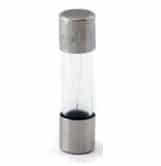In order to know the meaning of the term fuse, it is necessary, first of all, to discover its etymological origin. In this case, we can state that it derives from Latin, specifically from “fusio”, which means “that can be melted” and that it is the result of the sum of the following lexical components:
-The verbal form “fusum”, which is the supine of “fundere”, which is synonymous with “melt”.
-The suffix “-ible”, which can be translated as “that can”.
The first meaning mentioned by the Royal Spanish Academy ( RAE ) refers to an adjective that qualifies something that is susceptible to melting (that is, it can be melted, reduced or, if it is an electrical device, damaged).
 The most common use of the term, however, refers specifically to a component of electrical installations that, when the current becomes excessive, melts and interrupts it. A fuse, in this framework, is a metal sheet or wire .
The most common use of the term, however, refers specifically to a component of electrical installations that, when the current becomes excessive, melts and interrupts it. A fuse, in this framework, is a metal sheet or wire .
Fuses are a sheet or filament made of an alloy or metal that is characterized by having a low melting point. This element is located at a strategic point in the electrical installation so that it melts if the current intensity exceeds a certain value. Thus, when it melts, the fuse generates a current interruption and safeguards the integrity of the conductors , minimizing the risk of fire .
It can be said that a fuse is a protection element against eventual failures that may occur in an electrical circuit . Fuses are present in household appliances, automobiles and industrial installations, for example.
There are a wide variety of fuses on the current market. However, among the most significant are some such as the following:
-The cartridges, which are identified because they are made up of a tube that is made of insulating material.
-The cylindrical ones, which get their name because they are cylindrical-shaped tubes that are made of ceramic. Inside is where the sheet is located, which is responsible for performing the function of the fuse.
-Encapsulated glass, which are glass tubes that have a sheet and metal wire inside.
-The lead ones. Of these, we can point out the fact that they are the oldest in existence and that they are increasingly out of use because they rust quite easily.
-Those with blades, which can be of two types: with striker and without striker. They also respond to the name NH.
-Those with screw-on caps, which are cylindrical tubes made of porcelain.
-The chicote, which are identified by having lead or metallic thread.
While certain devices have a single, very small fuse, other devices may have several hundred fuses that can weigh up to twenty kilograms. In all cases, its function is the same: to interrupt the flow of electric current when the intensity increases dangerously. The circuit breaker is another device that, in the event of a short circuit or an increase in intensity, prevents current from continuing to flow.
